Seville is a treasure trove of architectural wonders, culinary delights, and lively traditions. Strolling the streets of the historic old town, visiting the Cathedral and the Royal Alcazar, dining on tapas, watching a flamenco show, and photographing the amazing Plaza de España all make the list of the best things to do in Seville.
With its colorful buildings, scenic streets, tree lined squares, and sunny skies, Seville is often labeled as one of the best most beautiful cities in Europe. It’s also a favorite city of many travelers to Spain.
This guide starts off with the top 10 things to do in Seville, perfect for those who are planning a quick visit to the city (1 to 2 days). We then go on to list more things to do in Seville, for those with more time.
I do my best to keep the hours of operation and pricing up to date for each attraction, however, these can change at any time. I recommend getting updated hours and pricing for your dates of travel. The link to the official website is provided for each site.
Top 10 Things to Do in Seville
This list starts with the very best things to do in Seville. These are essential experiences to have, particularly if it is your first visit to Seville.
1. Plaza de España
Plaza de España, aka the Spanish Square, is the most iconic sight in Seville.
Star Wars fans may recognize it from Epsiode 2: Attack of Clones. This square was the location of Theed on the planet of Naboo. It was also a filming site for Lawrence of Arabia.
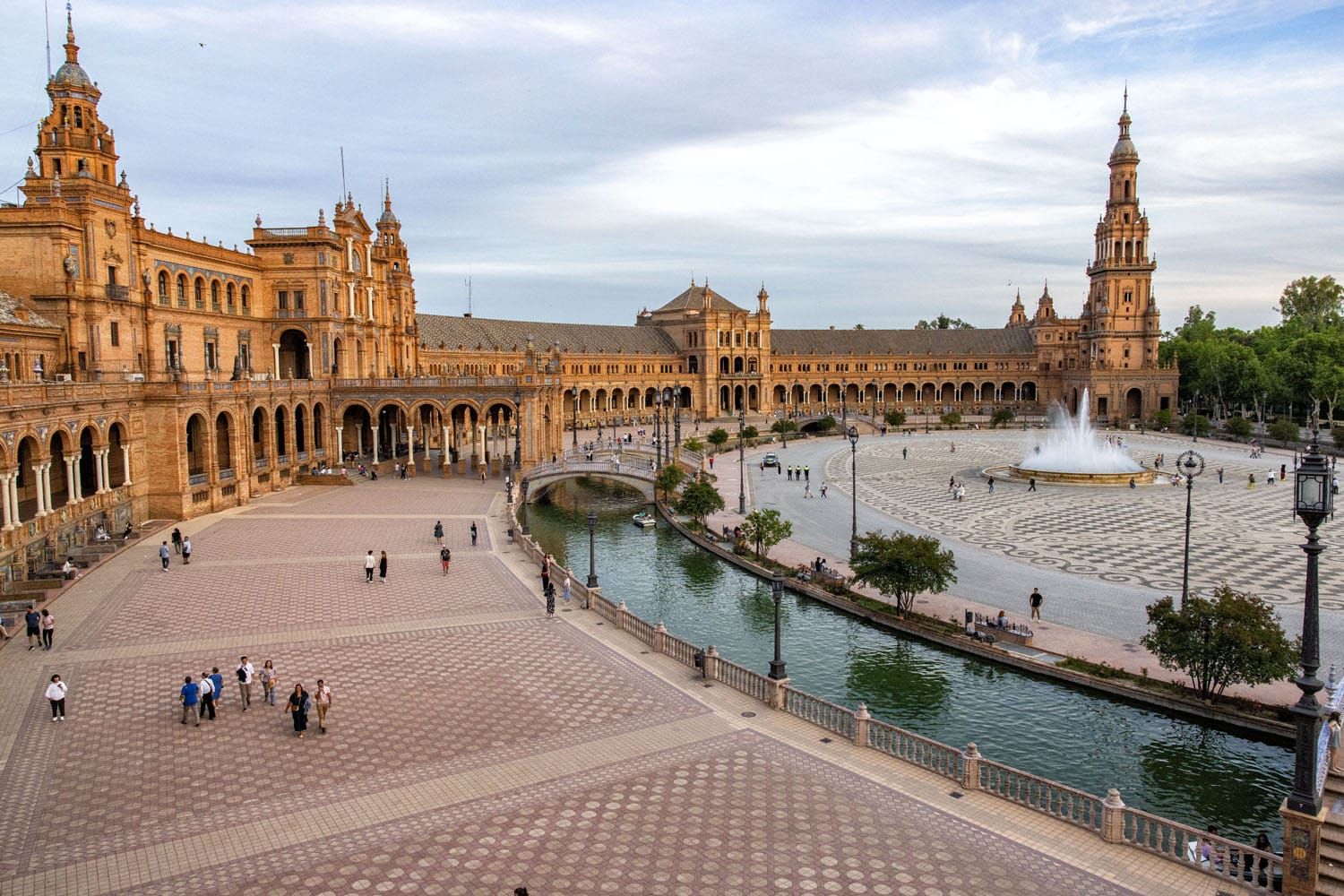
Plaza de España
This square was built for the the Ibero-American Exposition World’s Fair in 1929. It was designed by Aníbal González and sits in Maria Luisa Park.
A semicircular complex of buildings, built with a blend of Spanish Baroque Revival, Art Deco, Spanish Renaissance Revival, and Neo-Mudéjar styles, surrounds the centerpiece, the Vicente Traver Fountain.
The thing that really makes this square special are the 52 benches that line the square (note, the number of these benches ranges from 48 to 52 depending on the source). Each bench is covered with a colorful mosaic of tiles that depicts a different Spanish province.




On a visit here, you can cross the bridges over the moat (these bridges are very popular photography spots), stroll along the square to see the benches and tilework, and climb the steps to the first level for slightly elevated views over the square. You can also rent rowboats and drift along the moat.
During our visit in 2024, the towers were not open and the first level was as high as we could go. The buildings house government buildings which are off limits to visitors.
Plaza de España is open 24 hours a day and free to visit.
2. The Royal Alcazar of Seville & the Gardens
The Royal Alcazar (aka the Real Alcázar) is one of the oldest royal palaces in use in Europe. The Spanish royal family stays here when they visit Seville.
The first buildings of this complex date back to the Middle Ages. It was later enlarged, and Mudejar, Gothic, Islamic, and Baroque architectural elements were added to the palace. In 1987, UNESCO declared it a World Heritage Site.
Like Plaza de España, the Royal Alcazar has been featured in movies and TV series. Game of Thrones fans will recognize the gardens and some of the palace rooms as the Kingdom of Dorne (in particular, the gardens and the Hall of Ambassadors).
There is a lot to see and do here, with the highlights being the Lion’s Gate (this is the entrance into the Alcazar), the Hall of Ambassadors (its dome ceiling, intricate tilework, and arches make this one of the most awe inspiring rooms of the palace; it is located inside the Pedro I Palace), Patio de Banderas, Patio de Doncellas, and the gardens (don’t miss the long outdoor corridor with views over the gardens).
A visit here lasts anywhere from 45 minutes to two hours, depending on how fast you move and how much of the gardens you choose to explore.
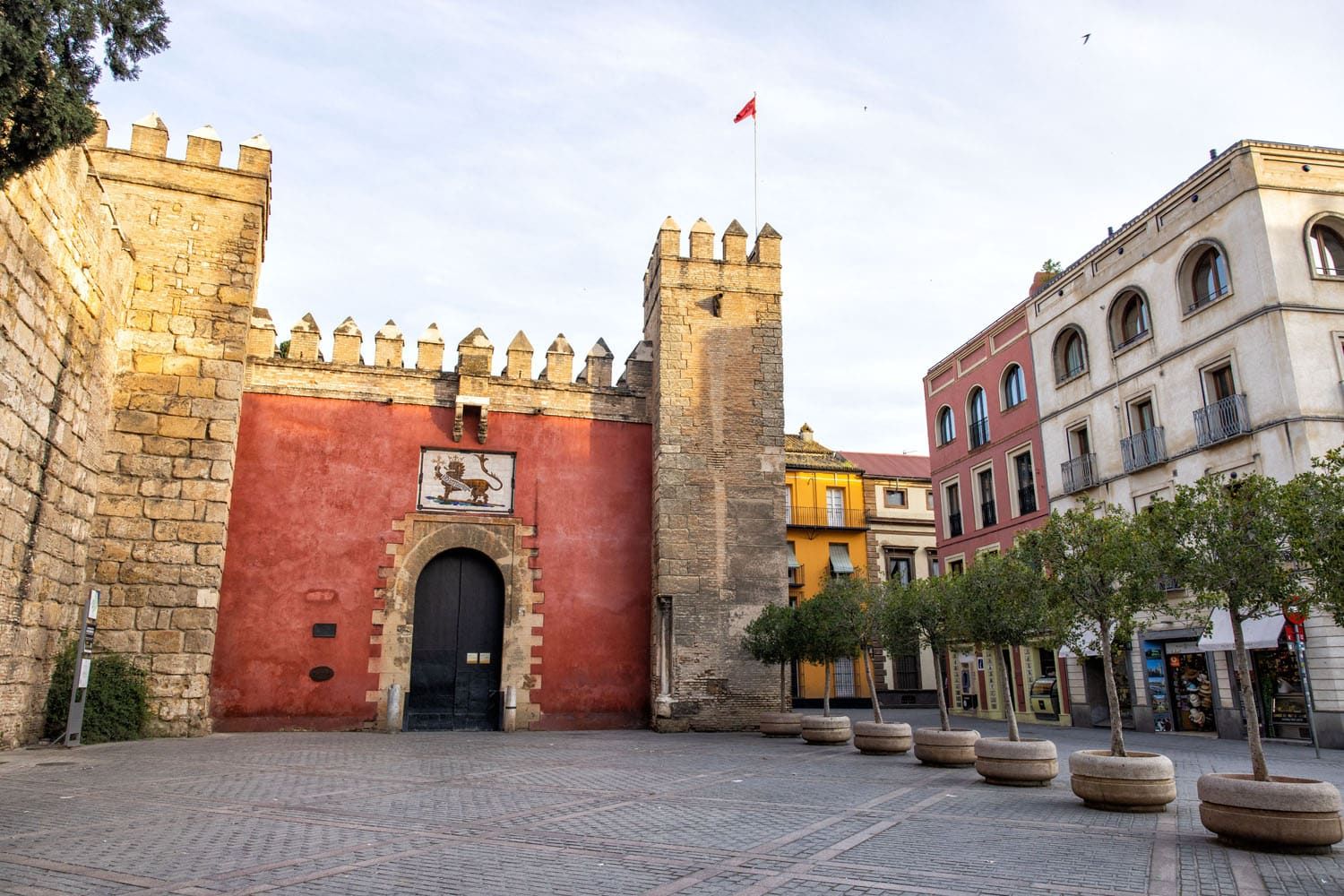
Lion’s Gate (Puerta del León)

Patio de Doncellas

Archways in the Hall of Ambassadors
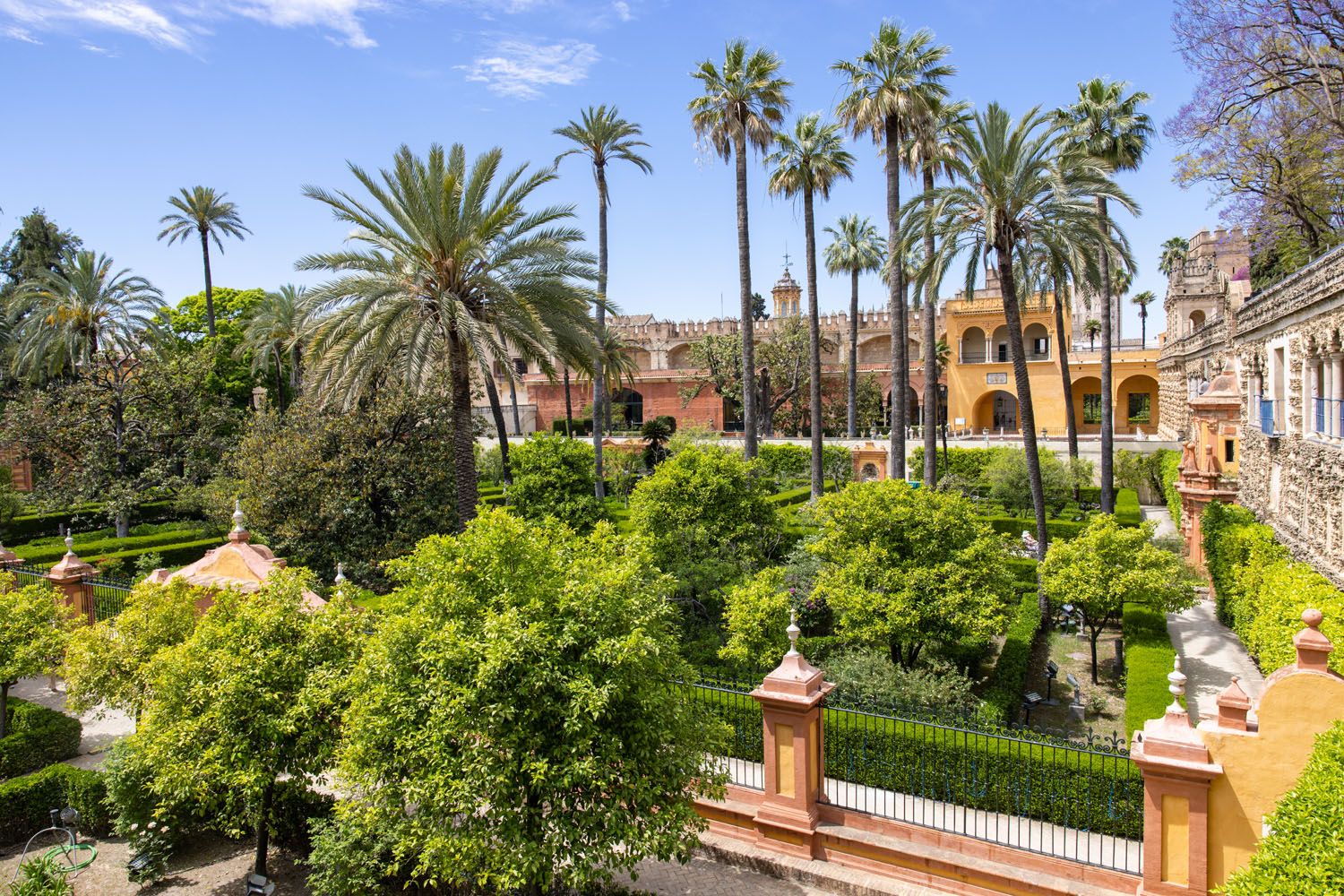
Royal Alcazar Gardens
How to Visit the Royal Alcazar & Gardens
To visit the Royal Alcazar, you will need to purchase a timed entry ticket in advance. This is best done on the official website and for a few more euros you can add on a guided tour of the Royal High Room. If tickets are sold out, they can also be purchased on GetYourGuide.
The Royal Alcazar is open 7 days a week from 9:30 am to 7:00 pm from April 1 to October 28, with reduced hours the remainder of the year. It closes for several major holidays during the year. Get updated hours on the official website.
3. The Seville Cathedral
This cathedral, which also goes by the name the Cathedral of Saint Mary of the See, is the largest Gothic cathedral in the world. Like the Royal Alcazar, it is listed as a UNESCO World Heritage Site. It sits in the center of Seville, just a few steps from the Royal Alcazar.
When the Seville Cathedral was completed in the early 16th century, it knocked the Hagia Sophia off the list of the largest cathedrals in the world. It still remains one of the largest churches in the world, however, St. Peter’s Basilica in Vatican City and the Milan Cathedral in Italy are larger.

This cathedral started off as a mosque, which was completed in 1198. It was later converted into a Christian cathedral and then enlarged to show off Seville’s wealth. The cathedral was completed in the very early 16th century although repairs and additions were added in subsequent centuries.
The Seville Cathedral has the longest nave in Spain. Within the cathedral are 80 chapels as well as a bronze tomb that contains the remains of Christopher Columbus. One of the prettiest places to visit is the courtyard, a shady oasis of orange trees and great views of the intricately carved bell tower.

Interior of the cathedral

Tomb of Christopher Columbus

Courtyard of the Seville Cathedral
How to Visit the Seville Cathedral
Tickets: For the best experience, purchase your tickets online in advance from the official website. There is an onsite ticket office but prices here cost 1 additional euro and you risk a long wait in the ticket line. When you purchase your ticket online, you will select a time slot for entry. You can stay in the cathedral as long as you like, or until it closes, of course.
As for ticket types, the cheapest option is an unguided visit €13 (this includes Giralda Tower). An audioguide costs €5. There are also several guided tours, including a guided tour of the rooftops or a guided tour to see the stained-glass windows.
Tickets to the Seville Cathedral also include entry into the Church of Our Divine Savior (the Church of El Salvador).
Hours: Hours vary by season but in general, the cathedral is open Monday to Saturday 11 am to 7 pm and Sunday 12:00 pm to 7 pm with reduced hours fall through spring. Get updated hours for your visit here. I have also noticed that in the summer, opening hours are earlier, around 10:35 am.
Dress Code: There are signs stating that shoulders and knees need to be covered but this was not being enforced during our visit.
Time: A visit to the cathedral and Giralda Tower lasts about 75 minutes.
4. La Giralda
La Giralda is the bell tower of the Seville Cathedral.
Like many places in Seville, this bell tower has a long history. It is the former minaret of the mosque that stood on this site before the cathedral was constructed. After the Reconquista, it was converted to a bell tower.

La Giralda
One of the best things to do in Seville is to climb to the top of La Giralda for panoramic views of the city. To do this, you will walk up roughly 40 ramps, which spiral up the inside of the tower, ending with a short climb up 17 steps to the outdoor viewing platform.
From the platform, it can be a bit tricky to take photos since a mesh covering surrounds the platform. Phones with smaller cameras will work but even some of the larger phone cameras may get some of the mesh in the photo.

iPhone photo from the top of La Giralda
Fortunately, there are numerous windows along the ramps that offer similar views without the mesh covering. Near the top of the tower, these windows offer the best places to take photos.

The view from one of the upper windows of the tower (not from the top platform).

Another view from the windows along the ramp of La Giralda.
This was one of the most crowded things we did in Seville. It was basically a long line of people walking to the top and the outdoor platform was jammed packed with visitors. But it is a lot easier to walk up the ramps versus a huge staircase of spiral, stone steps, like in many other bell towers in Europe.
HOW TO VISIT LA GIRALDA: Access to the tower is inside of the Seville Cathedral. You will need to purchase a ticket to the Seville Cathedral (best done online in advance) and this includes the tower climb.
5. The Historic City Center
Strolling through the city center, with its labyrinth of narrow streets, leafy squares, and shopping areas, is a great way to spend a few hours of your time in Seville.
If shopping is your thing, there is a cluster of streets with boutique shops and name brand stores. Calle Sierpes and Calle Tetuan run parallel to each other and are linked together by Calle Rioja and Calle Jovellanos (a lovely street with a nice view of the Chapel of San José).

Calle Sierpes

Calle Sierpes
Picturesque places to visit in the city center include Plaza del Salvador, the streets that surround the Seville Cathedral, and Plaza del Cabildo. As you wander the streets, you will see a lot of bitter orange trees, not only in the squares but lining many of the streets in Seville.

Chapel of San José

Edificio de La Adriática
6. Dine on Tapas
Tapas are small plates or snacks and make it onto many menus throughout Spain. In Seville, sampling a few tapas at one or more restaurants is one of the best ways to experience the culture of this city.
In Seville, popular tapas dishes include gazpacho, Jamón ibérico, fried and grilled fish and seafood, and grilled and stewed meats.
We tried several tapas restaurants in Seville, our favorites being La Brunilda and Vuela Tapas & Cocktail (this one has a very convenient location near the Seville Cathedral). El Rinconcillo is the oldest restaurant in the city and serves tapas and traditional Andalusian cuisine.


Tapas at Vuela
7. The Jewish Quarter
The Jewish Quarter is a tangle of very narrow streets near the city center of Seville. It is located just outside of the walls of the Royal Alcazar and extends east, towards Plaza de Santa Cruz.
We found exploring the streets just outside of the Alcazar, namely Calle Juderia, Calle Vida, and Calle Susona very enjoyable and a nice, quick stroll. There are a few tapas restaurants in the area as well as Hospital los Venerables, an art museum.
Another notable spot in this area is Rosina’s Balcony. Legend has it that this balcony inspired the opera The Barber of Seville.

Jewish Quarter

Jewish Quarter

Rosina’s Balcony
8. Palacio de las Dueñas
Constructed in the 15th century, with a blend of Gothic, Moorish, and Renaissance influences, Palacio de las Dueñas is one of the most beautiful places to visit in Seville (it’s also the header photo for this article).

Palacio de las Dueñas

On a visit here, you will tour the inner courtyards and decorated rooms of the palace. The gardens are beautiful (our visit was in late April, a fantastic time to visit Seville) but the highlight for us was the main courtyard, with its Moorish archways and manicured gardens.
This palace resembles the Royal Alcazar, but its smaller scale and fewer visitors makes it a more enjoyable experience, in our opinion.
Tickets can be purchased online in advance or at the entrance. Visit the official website for hours of operation, ticket prices, and to purchase your tickets in advance.
9. Flamenco
Flamenco got its start in Andalusia and it was the traditional music of the gypsies (gitanos). Now, flamenco is deeply rooted in Spanish culture and watching a flamenco performance is one of the top experiences to have in Seville.
Flamenco is a deeply emotional performance, a mix of singing, guitar playing, and dancing, usually with a lot of percussive footwork.
To watch flamenco in Seville, this performance at Casa de la Memoria gets very good reviews, as do the live performances at the Flamenco Museum.
10. Setas de Sevilla, aka the Metropol Parasol
Setas de Sevilla is the largest wooden structure in the world, according to the official website.
It was built between 2006 and 2011 and given the name Metropol Parasol. Its design was inspired by the vaults of the Seville Cathedral, but the structure looks more like mushrooms than a vaulted cathedral, so it got the nickname “setas,” which means “mushrooms.”

Setas de Sevilla


The view from Setas de Sevilla
You can either gaze up at the structure from street level or walk the series of walkways that wind around the top of the setas. To enter, there is a basement level below the Setas de Sevilla where you can purchase your tickets. An elevator whisks you to the top and here you can walk the elevated walkways. The view is very nice and a visit here lasts about 30 minutes.
Get hours and pricing on the official website.
With More Time in Seville
11. Have Drinks with a View at a Rooftop Bar
Sipping on a cocktail or a glass of wine is the perfect way to wind down after a day of sightseeing, and from a rooftop bar, you also get to enjoy the view.
There are several rooftop bars in Seville that we recommend.
Our favorite is La Terrazza del Hotel Inglaterra. From its enormous terrace you get an impressive view of Seville with the cathedral in the distance. This terrace is further from the cathedral than the other rooftop terraces we list next but that allows you to see more of the cathedral. The terrace itself is much larger than the other rooftop terraces, with much nicer seating (tables and sofas, some in shade and some in sun). If you only visit one rooftop terrace then this is the one to visit. They serve drinks only, no food.

La Terrazza del Hotel Inglaterra
Our second favorite is Pura Vida at Hotel Los Seises. This terrace has a mix of sofas and tables, some in the shade, some in the sun. The signature cocktails are very creative and the view of the cathedral and La Giralda is wonderful. The terrace opens at 4 pm and starting at 7 pm tapas are served. Check hours on the official website.

Pura Vida at Hotel Los Seises
The Terrazza Bar at Hotel Doña María Sevilla and La Terrazza del EME are located much closer to the cathedral. Of these two, we recommend La Terrazza del EME. It is a small terrace but has a great, up-close view of the cathedral and its tower. The overall setting and drinks aren’t as nice as Pura Vida or at the Inglaterra, but this makes for a great spot to get a drink in the evening and gaze out at the cathedral.

La Terrazza del EME
12. Plaza de América & Parque de María Luisa
This 40-hectare park was the first urban park built in Seville. It is an enormous green space that also contains a few popular landmarks.
Plaza de España is the most well-known landmark in Maria Luisa Park, which was mentioned earlier in this guide.
Plaza de América is located at the southern end of the park, about a 10-minute walk from Plaza de España. This plaza is lined with three buildings, the Museum of Popular Arts and Customs, the Archaeological Museum, and the Royal Pavilion, all built in different architectural styles.

Plaza de América and the Museum of Popular Arts and Customs

Queen’s Sewing Box
Sitting just outside of the park, on the western edge, is the Queen’s Sewing Box (the Costurero de la Reina). It was the first neo-Mudejar building built in Seville and another popular photography spot in the city. It now houses administrative offices for the tourism board.
13. The Museum of Fine Arts of Seville
Also called Museo de Bellas Artes de Sevilla, this art museum contains works of art from the medieval times through the early 20th century plus paintings from the Golden Age of Seville. The building that houses the museum was built in the 16th century as a convent and is also a sight to see.
If you are an art lover, a visit here is well worth your time. But if art is not your thing, I don’t think this museum needs to be high on your to-do list.
Get hours and pricing on the official website. The museum is closed on Mondays.
14. Torre del Oro
Sitting on the east bank of the Guadalquivir River, this ancient tower dates back to the early 13th century. Additions were made to the tower in the 14th century and the 18th century, increasing its height. In 1931, it was declared a historical-artistic monument. It gets its name because it was once covered in gold-colored tiles.

Torre del Oro
There are two parts to a visit here. The interior of the tower houses a maritime museum, with exhibits on several floors.
Most people visit the tower for the view, which is nice, but not nearly as good as the view from the Setas de Sevilla or La Giralda. From ground level, you’ll climb 92 steps to the main terrace, where the views are somewhat obstructed by the outer stones of the tower. Climb 12 more steps to a slightly higher terrace and for unobstructed views of the Seville Cathedral and historic city center.
The visit is free although donations (in cash) are greatly appreciated.

The view from Torre del Oro
15. Casa de Pilatos
This palace, also called the Pirate House, was built in the 15th century and altered several times since. It is now a beautiful blend of Italian Renaissance and Spanish Gothic styles. Similar to the Royal Alcazar and Palacio de las Dueñas, you will tour a few rooms of the house as well as the courtyard and gardens.

Casa de Pilatos
Get hours and pricing on the official website.
16. The Collegiate Church of the Divine Savior
This church, also called Iglesia Colegial del Divino Salvador, is a Catholic church located in the city center. It has somewhat of a unique appearance, with its red brickwork and Baroque architecture. Inside, it is gorgeous, and many visitors find this church to be more beautiful than the Seville Cathedral.
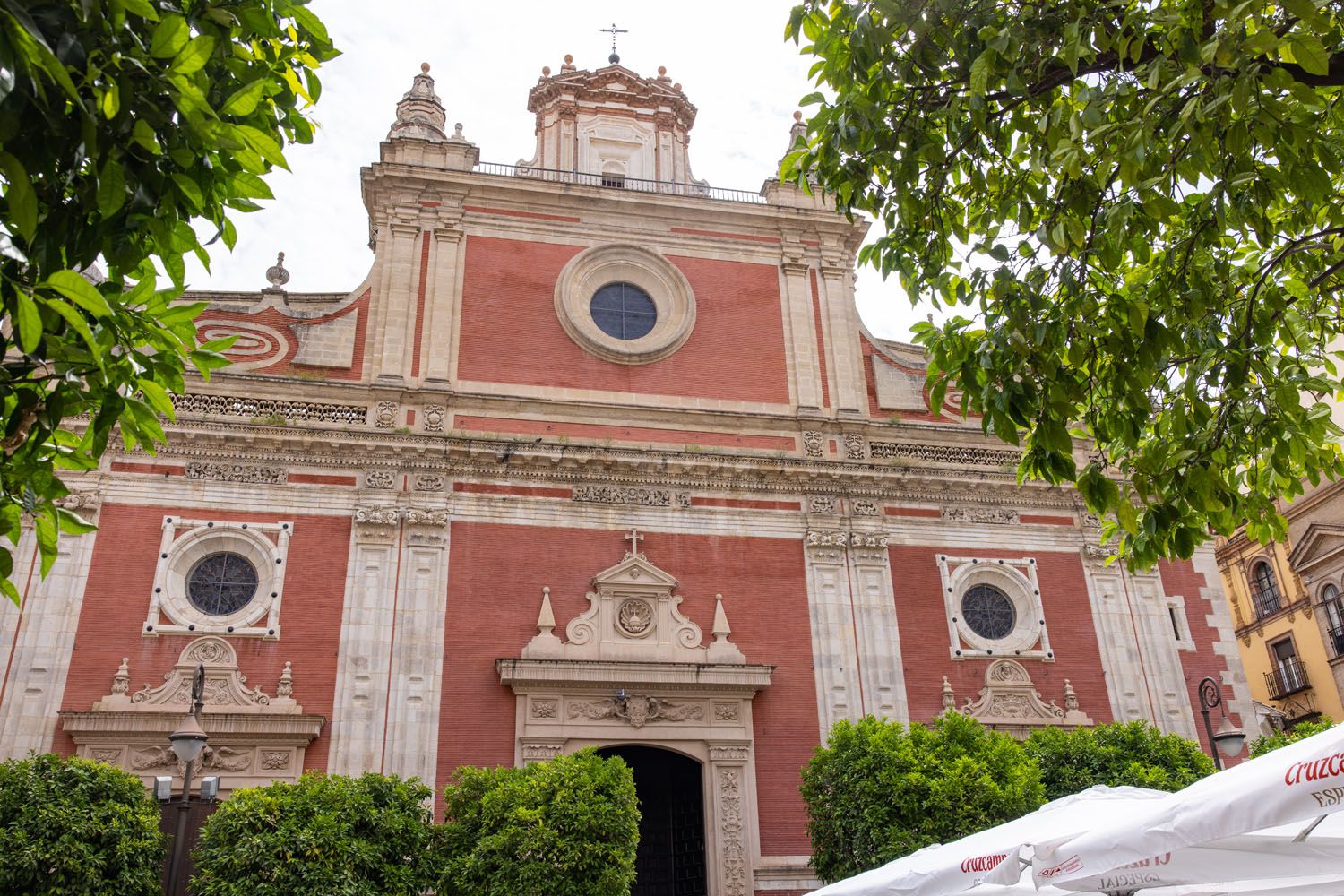
Collegiate Church of the Divine Savior
The Collegiate Church started off as the mosque of Ibn Adabbas. It was later converted into a Christian church and in the 17th century almost completely rebuilt.
The belltower shows the evolution of the church. The base is the remains of the minaret, the middle portion was built in the 14th century after the earthquake of 1356, and the upper part of the belltower was built by Leonardo de Figueroa in the early 18th century.
Inside of the church, don’t miss the Altarpiece of the Christ of Love and the Altarpiece of the Christ of the Afflicted, both masterpieces from the 17th century.

For pricing and hours, visit the official website. You can purchase a ticket to visit this church or a joint ticket with the Seville Cathedral.
17. Basilica de la Macarena
The main reason to visit this church is to see La Virgen de la Esperanza Macarena, a carving from the mid-17th century, that is one of the most famous processional figures of Seville. However, the inside of the basilica is beautiful, with multiple side chapels and frescos made by Rafael Rodríguez.

Basilica de la Macarena

La Virgen de la Esperanza Macarena
Next to the basilica is a museum that has on display floats from Seville’s Semana Santa festival and a treasury. Tickets for the museum are purchased in the gift shop next to the basilica.


The basilica is located north of the historic city center, a bit out of the way of the other sites already listed, but this church and the Madonna statue are of great importance in Seville.
18. Palace of the Countess of Lebrija
To see an impressive array of Roman mosaics, put this palace on your list. This is another gorgeous palace to visit, with Arabic-style arches, an open courtyard, numerous Roman mosaics, and works of art from ancient Greece.
Get hours and pricing on the official website.

Palace of the Countess of Lebrija
19. Real Maestranza de Caballeria de Sevilla
If you want to learn more about the history and culture of bullfighting, one of Andalusia’s oldest traditions, daily tours are held at the bullfighting ring and the attached museum, which has exhibits dating back hundreds of years.
20. Attend a Festival in Seville
Festivals are held in Seville throughout the year but there are two in particular we think visitors should be aware of. These are Semana Santa and the April Fair, which both occur in spring. Visiting Seville during these weeks can be a great way to experience more of the city’s vibrant culture.
Semana Santa
Semana Santa is the holy week before Easter. There are numerous processions and parades in the city as a tribute to the Passion of Christ. Important statues are removed from the churches, attached to intricately designed floats, and then entered into these processions.
The festivities last all week, but the most important night is Holy Thursday leading into Good Friday. One of the most significant processions is the Macarena, the procession of La Virgen de la Esperanza Macarena from Basilica de la Macarena.
This is one of the busiest times of the year to visit Seville. Not only do friends and families gather together to watch the processions but visitors from all over the world travel to Seville to participate in the festivities. Many bars and restaurants close during this week so a visit at this time will be more about attending the religious ceremonies.
The April Fair
This festival also spans one week and marks the start of the bullfighting season. It is a week of light displays, flamenco, food, and drinks and is sometimes referred to as the festival in Seville. It takes place every year, starting two weeks after Semana Santa.
Seville Bucket List: On a Map
How to Use This Map: Click the icons on the map to get more information about each point of interest. To take this map with you, click the star next to the title of the map which adds it to your Google account. Next, within your Google Maps app, select ‘Saved’ and then select ‘Maps’. This map title will now appear in your list.
Frequently Asked Questions
What should you not miss in Seville?
The top sights in Seville include Plaza de España, the Seville Cathedral, the view from La Giralda, a visit to the Royal Alcazar and its gardens, plus learning more about the culture of Seville through its food (tapas!) and flamenco shows.
How many days do you need in Seville?
It’s possible to visit the main key sights in just one day in Seville. Two days gives you just enough time to also explore its neighborhoods, visit a palace or two, and sample tapas at several different restaurants. Three days is the perfect amount of time to visit Seville’s top spots plus have some free time, to either relax or go off the beaten path.
When is the best time to visit Seville?
Spring and fall are the best times to visit Seville, when the weather is warm. Seville is one of the hottest places to visit in Europe in the summer, so unless you don’t mind scorching temperatures, it’s best to visit this city in the spring and fall. Even winter can be quite nice, with cool temperatures and low crowds.
Our visit was in late April. The average daily high temperature was 24°C/75°F with mostly clear skies during our three days in Seville.
If you have any questions about the best things to do in Seville or how to plan a trip to Seville, let us know in the comment section below!
More Spain Travel Guides
We have TONS more information about Spain in our Spain Travel Guide, including Barcelona, Madrid, Seville, Andalusia, and the Rioja Wine Region.










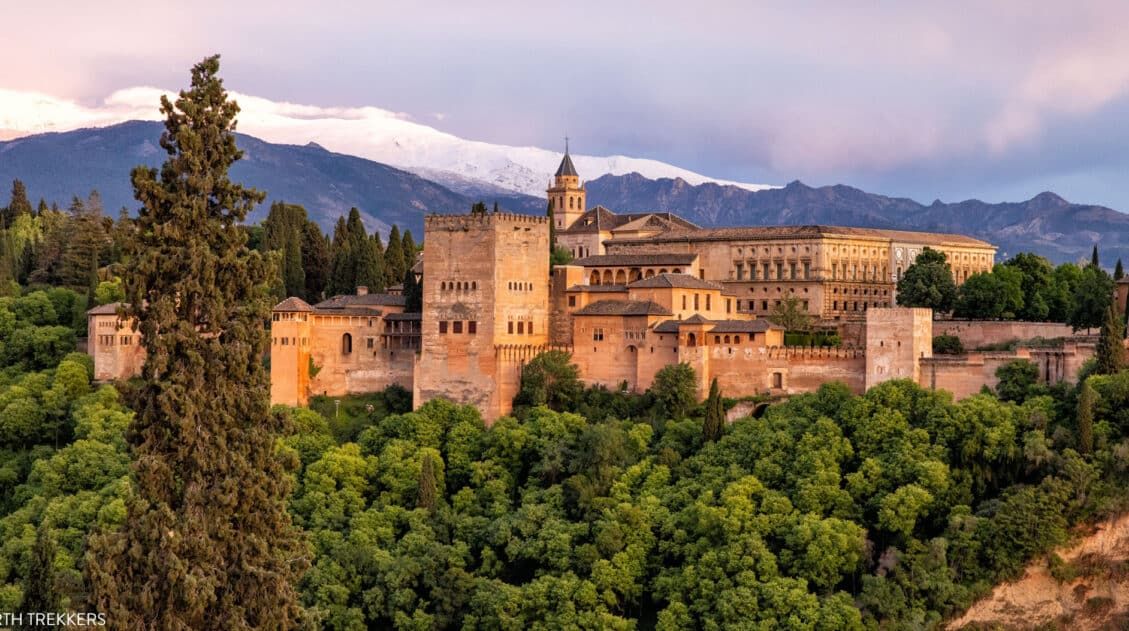

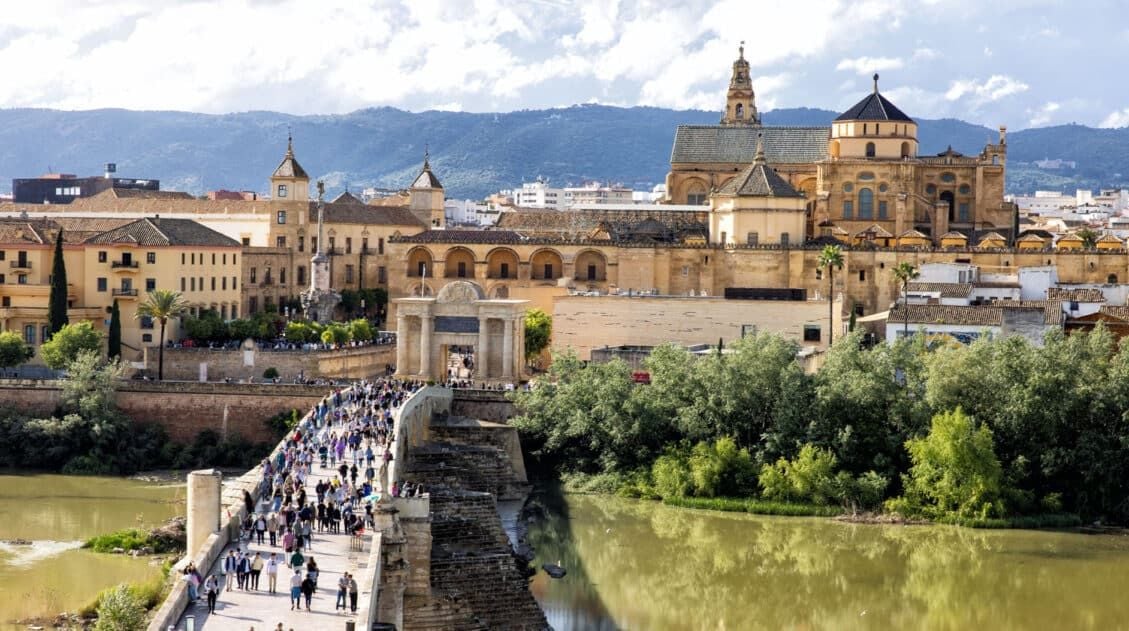




Comments 2